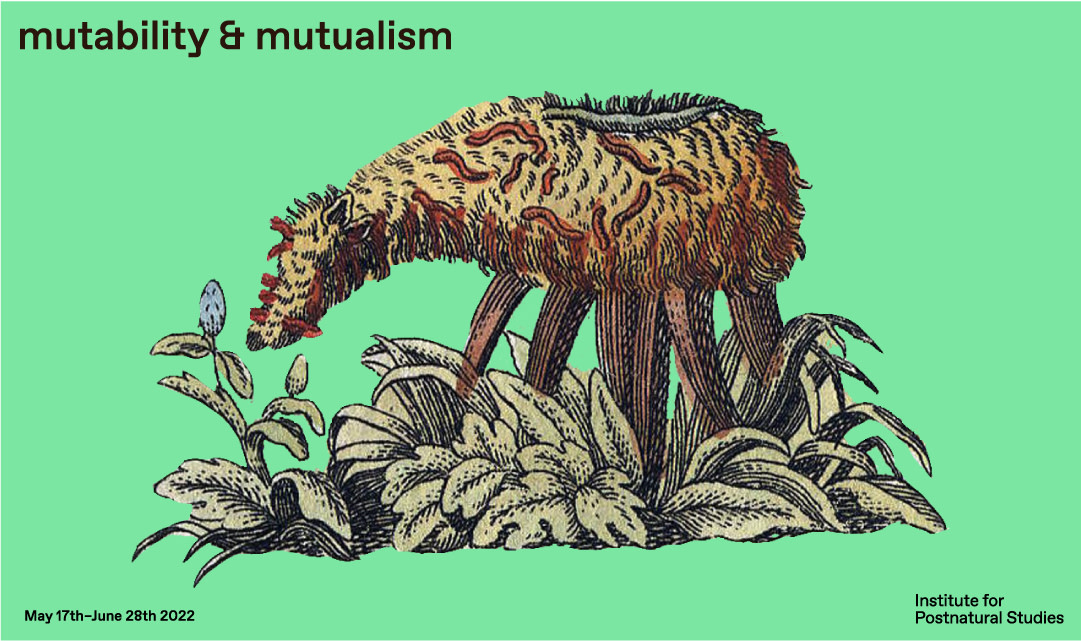Mutability and Mutualism
No. of sessions
6 sessions
120 min each
Date
May 17th
To June 28th
Time
From 19:00 to 21:00
(CET / CEST)
Language
English
In collaboration with
Institute of Queer Ecology

Queer Ecology is a theoretical framework that applies queer theory to environmental concerns, ecological constructs, and our relationships with nature. Queerness and ecology together make visible the interconnected, entangled conditions of life on earth and honour the strange, multispecies amalgamation we live in community with. To make sense of the broad constellation of practices that emerge from Queer Ecology, we examine at two scales: the individual and the collective. As we explore, the binary distinction between these scales quickly blurs and blends.
At the scale of the individual—the organism—Queerness is mutability: it is the power of transformation; of shapeshifting, fluency, and the freedom to move from form to form; of code-switching, mimicry, flamboyance, delight; of subtlety, grace, and the embrace of fluidity. It plays in contrast to rigidity, permanence, and stasis; to one way of being. It is metamorphosis and a constant becoming.
At the scale of the collective—the ecosystem—Queerness is mutualism: it is symbiotic, in-contact, relational; it is a space of eccentric economies and mutual support; of found families and utopian dreams; of care and connection and the net benefits species gift one another. It is a world shaped through cooperation. On a rapidly changing planet, Queer mutability and mutualism can guide us toward adaptation and survival.
The speakers in this seminar series will consider the influence of mutability and mutualism on their work in the fields of visual art, evolutionary biology, biodiversity, environmental activism, synthetic biology, ecology, and queer theory.
Speakers
Graham Bell Tornado
Graham will talk about their long-term engagement with queer ecology focusing on the How to Heal cycle of participatory rituals, which invoke the spirits of extinct species to bring about transformation in our society, and on more recent works which question the concepts of nation, territory, and colonialism. Their recent P.I.N.Q. (Post Industrial Natural Queer) Park ceremony was carried out on the island of La Gomera in the Canary Islands from where Columbus set sail on his voyage of “discovery” of the new world.
Mary Maggic
Mary Maggic (b. Los Angeles, '91) is a nonbinary artist working at the intersection of hormones, body and gender politics, and ecological alienations. Maggic frequently uses “biohacking” as a xeno-feminist practice of care that holds the potential to demystify invisible systems of molecular biopower. Completing their Masters in the Design Fiction group at MIT Media Lab, Maggic is a current member of the global network Hackteria - Open Source Biological Art, the tactical theater collective Aliens in Green, the Asian feminist group Mai Ling Vienna, as well as a contributor to the radical syllabus project Pirate Care and to the online Cyberfeminism Index.
Noam Youngrak Son
Noam Youngrak Son is a designer based in Ghent and Eindhoven. They inscribe myths for the underrepresented in various mediums, from books to performances to 3D-printed sex toys. They are excited about the unexpectedness that a well-designed fiction can open up, and the critical political discussions that it may cultivate. They use their capability as a designer to visualize and materialize the setup for the technological & ecological bodies in their fiction to play roles. Their identity as queer people of color is one of the crucial axes of their design practices.
Reverend Houston R. Cypress
Reverend Houston R. Cypress is a two-spirit poet, artist, activist, and ordained minister from the Otter Clan of the Miccosukee Tribe of Indians of Florida. He resides on the Miccosukee Reservation located west of Miami, Florida; and he maintains a number of traditional villages located on tree islands scattered throughout Water Conservation Area 3A — the area known as the historic River of Grass, and called by his community: KAAHAYATLE, which can be translated as “Shimmering Waters.”